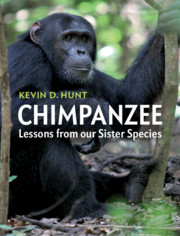Book contents
- Chimpanzee
- Reviews
- Chimpanzee
- Copyright page
- Dedication
- Contents
- Foreword
- Preface
- Acknowledgments
- 1 Sister’s Keeper
- 2 Wild Lesson
- 3 A Most Surprising Creature
- 4 Kin
- 5 Scratching Out a Living in an Unforgiving World
- 6 Guts, Glorious Guts, Large Stomach, and Colon
- 7 Thews, Sinews, and Bone
- 8 Arboreal Gathering, Terrestrial Traveling
- 9 Forged in Nature’s Cauldron
- 10 Up from the Protoape
- 11 Building a Natural Wonder
- 12 The Source of Similarity
- 13 Making Your Way in the Great Wild World
- 14 The Grim Reaper in the Forest Primeval
- 15 Powering Life
- 16 Shelter from the Storm
- 17 Meat-Seeking Missiles
- 18 The Mind of the Chimpanzee
- 19 The Brain of the Chimpanzee
- 20 Tired Nature’s Sweet Restorer
- 21 Chimpanzee Thought Transfer
- 22 Ape Implements
- 23 Wisdom of the Ages
- 24 The Daily Grind
- 25 A Nation at War with Itself
- 26 The Sporting Chimpanzee
- 27 The Passion of Pan
- 28 Into the Light
- 29 The Other Sister, Bonobos
- 30 Sister Species
- Book part
- Index
- Plate Section (PDF Only)
- References
23 - Wisdom of the Ages
Chimpanzee Culture
Published online by Cambridge University Press: 10 July 2020
- Chimpanzee
- Reviews
- Chimpanzee
- Copyright page
- Dedication
- Contents
- Foreword
- Preface
- Acknowledgments
- 1 Sister’s Keeper
- 2 Wild Lesson
- 3 A Most Surprising Creature
- 4 Kin
- 5 Scratching Out a Living in an Unforgiving World
- 6 Guts, Glorious Guts, Large Stomach, and Colon
- 7 Thews, Sinews, and Bone
- 8 Arboreal Gathering, Terrestrial Traveling
- 9 Forged in Nature’s Cauldron
- 10 Up from the Protoape
- 11 Building a Natural Wonder
- 12 The Source of Similarity
- 13 Making Your Way in the Great Wild World
- 14 The Grim Reaper in the Forest Primeval
- 15 Powering Life
- 16 Shelter from the Storm
- 17 Meat-Seeking Missiles
- 18 The Mind of the Chimpanzee
- 19 The Brain of the Chimpanzee
- 20 Tired Nature’s Sweet Restorer
- 21 Chimpanzee Thought Transfer
- 22 Ape Implements
- 23 Wisdom of the Ages
- 24 The Daily Grind
- 25 A Nation at War with Itself
- 26 The Sporting Chimpanzee
- 27 The Passion of Pan
- 28 Into the Light
- 29 The Other Sister, Bonobos
- 30 Sister Species
- Book part
- Index
- Plate Section (PDF Only)
- References
Summary
Culture is widely viewed as the hallmark of humanity, a feature unique to human existence and not found among other beings. This distinction, of course, depends on your definition of “culture.” Many definitions follow that of E.B. Tylor (1874): “the sum total of what an individual acquires from his society – those customs, artistic norms, food-habits, and crafts which come to him not by his own creative activity but as a legacy from the past” (Lowie, 1937). If cultural phenomena are boiled down to a mere list, many would emphasize what society teaches its members about art, science, myth, literature, ethics, morality, tradition, and religion. In translating a definition such as that of Taylor and Lowie into something more useful for primates, we might follow that of the co-founder of Japanese primatology, Kinji Imanishi; he took a more pragmatic and streamlined approach. He defined culture as “socially transmitted, adjustable behavior” (Imanishi, 1952). In some quarters, among sociocultural anthropologists, for example, the question of whether chimpanzees (and some other animals) have culture is controversial (Galef, 1992), but among primatologists the possession of culture by chimpanzees is not the least bit controversial (Wrangham et al., 1996; Boesch & Tomasello, 1998; Whiten et al., 1999). Wild studies aside (Wrangham et al., 1996; Boesch & Tomasello, 1998; Whiten et al., 1999), chimpanzees learn to eat with a fork, drink from a cup, wear clothes, name objects, request a hug, and carry their favorite toys in a backpack; denying they possess culture seems willfully blind.
- Type
- Chapter
- Information
- ChimpanzeeLessons from our Sister Species, pp. 419 - 426Publisher: Cambridge University PressPrint publication year: 2020

